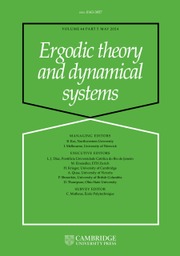No CrossRef data available.
Article contents
On uniqueness of invariant measures for random walks on  ${\textup {HOMEO}}^+(\mathbb R)$
${\textup {HOMEO}}^+(\mathbb R)$
Published online by Cambridge University Press: 29 April 2021
Abstract
We consider random walks on the group of orientation-preserving homeomorphisms of the real line  ${\mathbb R}$. In particular, the fundamental question of uniqueness of an invariant measure of the generated process is raised. This problem was studied by Choquet and Deny [Sur l’équation de convolution
${\mathbb R}$. In particular, the fundamental question of uniqueness of an invariant measure of the generated process is raised. This problem was studied by Choquet and Deny [Sur l’équation de convolution  $\mu = \mu * \sigma $. C. R. Acad. Sci. Paris 250 (1960), 799–801] in the context of random walks generated by translations of the line. Nowadays the answer is quite well understood in general settings of strongly contractive systems. Here we focus on a broader class of systems satisfying the conditions of recurrence, contraction and unbounded action. We prove that under these conditions the random process possesses a unique invariant Radon measure on
$\mu = \mu * \sigma $. C. R. Acad. Sci. Paris 250 (1960), 799–801] in the context of random walks generated by translations of the line. Nowadays the answer is quite well understood in general settings of strongly contractive systems. Here we focus on a broader class of systems satisfying the conditions of recurrence, contraction and unbounded action. We prove that under these conditions the random process possesses a unique invariant Radon measure on  ${\mathbb R}$. Our work can be viewed as following on from Babillot et al [The random difference equation
${\mathbb R}$. Our work can be viewed as following on from Babillot et al [The random difference equation  $X_n=A_n X_{n-1}+B_n$ in the critical case. Ann. Probab. 25(1) (1997), 478–493] and Deroin et al [Symmetric random walk on
$X_n=A_n X_{n-1}+B_n$ in the critical case. Ann. Probab. 25(1) (1997), 478–493] and Deroin et al [Symmetric random walk on  $\mathrm {HOMEO}^{+}(\mathbb {R})$. Ann. Probab. 41(3B) (2013), 2066–2089].
$\mathrm {HOMEO}^{+}(\mathbb {R})$. Ann. Probab. 41(3B) (2013), 2066–2089].
MSC classification
Information
- Type
- Original Article
- Information
- Creative Commons
- This is an Open Access article, distributed under the terms of the Creative Commons Attribution licence (http://creativecommons.org/licenses/by/4.0), which permits unrestricted re-use, distribution and reproduction, provided the original article is properly cited.
- Copyright
- © The Author(s), 2021. Published by Cambridge University Press


